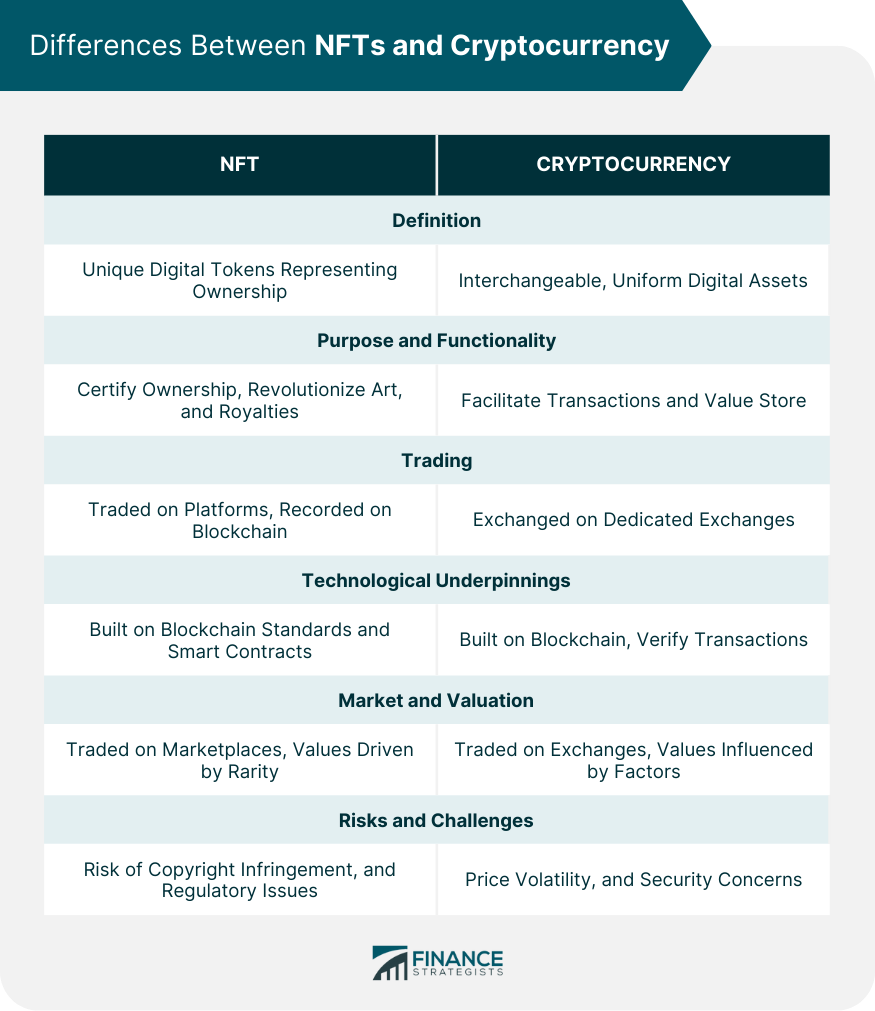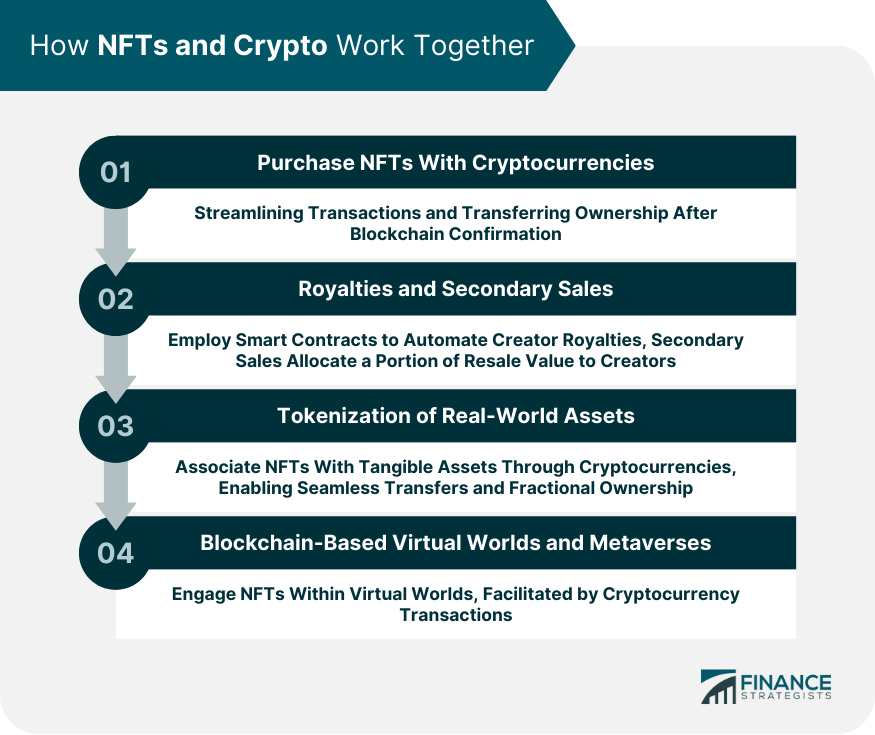NFT vs Cryptocurrency Overview
In today's rapidly evolving digital landscape, two groundbreaking concepts have captured the spotlight: NFTs (Non-Fungible Tokens) and cryptocurrencies.
NFTs, a relatively recent innovation, represents unique and indivisible ownership of digital items, spanning a wide range of applications such as digital art, collectibles, and even real-world assets.
Cryptocurrencies, on the other hand, have emerged as an alternative form of currency, underpinned by blockchain technology and cryptographic security.
With their potential to revolutionize financial transactions and challenge traditional monetary systems, cryptocurrencies have sparked a global wave of interest and investment.
As the digital economy continues to expand, both NFTs and cryptocurrencies have gained remarkable popularity and significance.
By understanding their unique attributes, and underlying technologies, you can shed light on the factors that differentiate NFTs from cryptocurrencies and the implications they hold for the future of digital transactions and ownership.
Difference Between NFTs and Cryptocurrency
Definition
NFTs are unique digital tokens that represent ownership of a specific item or piece of content.
Unlike cryptocurrencies, which are interchangeable and have uniform value, NFTs are non-fungible, meaning each token holds distinct characteristics, making it indivisible and irreplaceable.
This uniqueness is a core feature that has driven NFT adoption across various domains, including digital art, collectibles, virtual real estate, and more.
Cryptocurrencies, on the other hand, like Bitcoin and Ethereum, are fungible digital assets designed to function as mediums of exchange or stores of value, sharing the same value and properties regardless of individual units.
Purpose and Functionality
NFTs serve as digital certificates of authenticity, verifying ownership and source of digital or physical assets.
They've revolutionized the art and entertainment industries by enabling creators to tokenize their work, granting them the ability to earn royalties from secondary sales.
In contrast, cryptocurrencies primarily aim to facilitate peer-to-peer transactions and store value.
They transcend geographical boundaries and traditional financial systems, offering a decentralized approach to conducting financial transactions and potentially disrupting traditional banking systems.
Trading
Trading NFTs involves platforms that function as marketplaces, where individuals can buy, sell, and trade these unique digital items. The ownership and transaction history of each NFT are recorded on a blockchain, ensuring transparency and security.
Cryptocurrency trading operates on cryptocurrency exchanges, where individuals trade one type of cryptocurrency for another or exchange them for traditional fiat currency.
The trading dynamics for cryptocurrencies are often influenced by factors like supply and demand, technological developments, and market sentiment.
Technological Underpinnings
NFTs are typically built on specific blockchain standards like Ethereum's ERC-721 or ERC-1155, utilizing smart contracts to define ownership rights and attributes of the token.
These standards ensure interoperability and compatibility across various platforms.
Cryptocurrencies are generally built on blockchain technologies like Bitcoin's blockchain or Ethereum's blockchain, which utilize consensus mechanisms to verify and record transactions.
The focus here is on creating secure and tamper-proof decentralized ledgers.
Market and Valuation
NFT marketplaces, such as OpenSea and Rarible, have become central to trading NFTs, with values determined by factors like rarity, creator reputation, and demand.
Cryptocurrencies trade on dedicated exchanges such as Coinbase and Binance, with prices influenced by market sentiment, technological developments, regulatory changes, and macroeconomic factors.
While both NFTs and cryptocurrencies can experience periods of volatility, the factors driving their valuation differ due to their distinct purposes and markets.
Risks and Challenges
NFTs, while revolutionizing ownership verification, also introduce concerns around copyright infringement and legal uncertainties. The decentralized nature of NFTs can accidentally facilitate the tokenization of copyrighted material, sparking legal disputes.
Regulatory uncertainty further complicates matters, potentially leading to unexpected tax implications and compliance challenges for creators and investors.
Cryptocurrencies, while promising financial innovation, come with their own set of challenges. The volatile nature of cryptocurrency prices remains a central risk, driven by factors ranging from market sentiment to regulatory changes.
Furthermore, the security of cryptocurrency holdings is a pressing concern, with hacking incidents targeting exchanges and wallets exposing vulnerabilities within the digital asset world.

How NFTs and Crypto Work Together
NFTs and cryptocurrencies, though distinct in their core functions, are interconnected within the broader landscape of blockchain technology, presenting opportunities for innovative collaboration and synergy.
Purchase NFTs With Cryptocurrencies
Cryptocurrencies act as the primary means of exchange within the NFT ecosystem. Buyers often use established cryptocurrencies like Ethereum (ETH) to purchase NFTs on various marketplaces.
The transaction process involves sending the specified amount of cryptocurrency to the smart contract associated with the NFT. Once the transaction is confirmed on the blockchain, ownership of the NFT is transferred to the buyer's digital wallet.
This seamless integration of cryptocurrencies streamlines the purchasing process and enables a global market for NFTs, transcending geographical boundaries.
Royalties and Secondary Sales
When an NFT is resold on secondary markets, a predefined percentage of the resale price is automatically directed to the original creator's digital wallet.
This process is powered by cryptocurrencies, ensuring that creators continue to receive compensation for the value appreciation of their digital assets over time.
This royalty mechanism introduces a new paradigm for artists and content creators, who can benefit from the ongoing success of their creations.
Tokenization of Real-World Assets
By linking ownership of tangible assets to NFTs on a blockchain, cryptocurrencies can facilitate fractional ownership and seamless transfer of ownership. This has profound implications for asset classes such as real estate, art, and collectibles.
Investors can purchase fractions of these valuable assets using cryptocurrencies, democratizing access to traditionally exclusive markets.
Blockchain-Based Virtual Worlds and Metaverses
NFTs and cryptocurrencies converge in the emerging landscape of blockchain-based virtual worlds and metaverses.
These virtual environments allow users to own, trade, and interact with NFTs representing digital assets like virtual land, virtual goods, and avatars. Cryptocurrencies are integral for conducting transactions within these digital realms.
Users can buy virtual land using cryptocurrencies, and creators can monetize their virtual creations by selling them as NFTs, expanding the concept of ownership and economy within these immersive digital spaces.

Conclusion
The distinctive qualities of NFTs and cryptocurrencies highlight their respective roles in reshaping the digital landscape.
NFTs stand as unique certificates of ownership for digital and real-world assets, introducing unprecedented ways to verify authenticity and monetize creativity.
In contrast, cryptocurrencies serve as versatile digital currencies, enabling borderless peer-to-peer transactions and fostering decentralized financial systems.
Their collaboration is evident in the seamless purchase of NFTs using cryptocurrencies, the automation of royalties through smart contracts, and the tokenization of tangible assets using blockchain technology.
These intertwining functionalities pave the way for evolving economic models, democratized ownership, and innovative digital experiences.
The fusion of NFTs and cryptocurrencies propels us into a future where ownership, creativity, and value exchange take on new dimensions within an interconnected digital realm.
NFT vs Cryptocurrency FAQs
NFTs (Non-Fungible Tokens) represent unique ownership of digital items, while cryptocurrencies are interchangeable digital assets used for transactions.
NFTs can be bought with cryptocurrencies, and cryptocurrencies power the transactions and royalties associated with NFTs.
No, they serve distinct purposes. NFTs verify ownership of unique items, while cryptocurrencies are digital currencies or stores of value.
NFTs can tokenize real-world assets, while cryptocurrencies enable transactions for buying such NFTs or assets.
NFTs allow ownership of digital items within virtual worlds, and cryptocurrencies facilitate transactions and purchases in those digital environments.
True Tamplin is a published author, public speaker, CEO of UpDigital, and founder of Finance Strategists.
True is a Certified Educator in Personal Finance (CEPF®), author of The Handy Financial Ratios Guide, a member of the Society for Advancing Business Editing and Writing, contributes to his financial education site, Finance Strategists, and has spoken to various financial communities such as the CFA Institute, as well as university students like his Alma mater, Biola University, where he received a bachelor of science in business and data analytics.
To learn more about True, visit his personal website or view his author profiles on Amazon, Nasdaq and Forbes.











